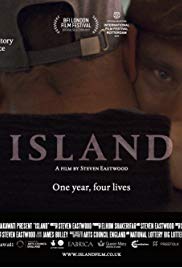
Authors: Julie Lang, Dr Sheri Mila Gerson, Dr Sarah Pickstock (Consultant, Palliative Medicine, NHS Dumfries and Galloway)
Steven Eastwood’s powerful documentary film Island was screened at Dumfries and Galloway Royal Infirmary as a part of Dying Matters Week. This was a collaborative event between the academic community of the End-of-Life studies Group and the clinical staff of the hospital, with the aim of promoting discussion and sharing our views on death and dying.
Nominated by the British Independent Film Award for best documentary, Island was made over the course of a year at the Earl Mountbatten Hospice on the Isle of Wight. It follows the stories of four individuals as they approach the end of their lives, supported by the carers, staff and facilities of the local hospice. All individuals had consented to appear.
In the film we see that death and the process of dying don’t come with a commentary, nor indeed does life. We see how people may experience and assimilate existence and identity moment by moment, surrounded by the natural world, enclosed by domestic space and bound by mortal bodies. The unfolding sequence proceeds in times of stillness, as well as motion, with and without our attention, in health and in sickness.
The film caused some controversy when it was first released because it shows several minutes as one of the central characters, Alan, is breathing until he finally takes his last breath. His dying is seen as gentle and slow; the peaceful culmination of an inevitable human process. We see Alan being cared for with respect and dignity both before and after his death. Some of the people at the screening commented how they were impressed that Alan was allowed to smoke in the facility and that carers had helped him to smoke. Several comments were made about how many patients have to leave behind smoking or other things important to them, when they are transferred to a facility or hospital – taking away from what is deemed to be patient centred care.
Alan imparts words of wisdom:
“There is no time but the now, the eternal now, the only thing that exists…it’s the only place we can live” Alan
Eastwood depicts the passage of time and the gradual physical decline of the individuals by utilising seasonal change. He parallels these changes with the watchful waiting of the families, the staff and the camera as the months pass.The documentary shows as much about the relationship that develops between the artist, the filmmaker, and the individual being filmed. At times, the film maker and the camera are spoken to directly as if they are integral to the story being told.
When Alan died, Eastwood had fallen asleep in his room with the camera still running. For some in our group, this brought back memories of deaths they had witnessed, or been unable to witness. Carers, artists, and filmmakers are seen as patient companions. Many viewing the film could relate to Eastwood’s experience of missing Alan’s final moments; it seems to be a common event in end-of-life care.
One of the individuals, Jamie, was determined to help his young daughter to understand what was happening and what his future held. Many of us could relate to the different ways friends and family cope with grief, shock, and disbelief with anticipated death.
The screening of this provocative documentary encouraged discussion about professional and personal experiences of death and dying from different perspectives. Some nursing students attending the screening who had never seen a death before, said they felt calmed by the film because it showed what a comfortable and expected death might look like. The academic staff were interested in the director’s motivation, the editing, the use of the images from the natural world and the many metaphors for illness, death, change and mortality. The clinical staff saw it as a very useful teaching tool for medical and nursing students, for members of the public who had not experienced death in such circumstances, and for encouraging conversations about fears of dying and death.
This joint venture confirmed the need for more open discussions about death and dying, and the advantage of having both clinical and academic points of view. In addition, it confirmed how art, film, and literature can be utilised to bring people together to talk about what for some of us, may be considered a difficult subject. Overall, it was a very engaging experience and we all agreed that a pubic showing later in the year would be a catalyst for further discussion of these emotive but important issues.

